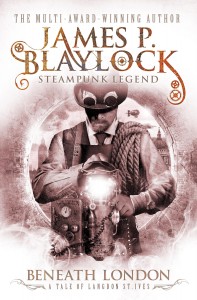
James P. Blaylock
Titan Books
Reviewed by Michael R. Collings
James P. Blaylock’s Beneath London is the long, dense, complex, multi-charactered sequel to The Aylesford Skull, with its hero, Professor Langdon St. Ives. St. Ives is central in this novel as well, primarily because all of the others peopling the tale revolve in some way around him: his wife and his servant/companion; his neighbors from Aylesford and their families and associates; his best friend, his best friend’s nephew, and a woman who might or might not be the friend’s fiancé; several individuals he encountered in the previous novel, including a fascinating dwarf with hidden but useful skills and a prodigious imagination…and a dead villain who might or might not be dead; and a living and horrendously vicious villain whose principle interest seems to be capturing St. Ives and doing his will upon him.
In addition to manipulating this large cast of players, the novel ingeniously exploits its setting—late-Victorian London. Much of the action takes place above ground, in warrens of streets glutted with the poverty-stricken and desperate, in the mansions of the wealthy, in respectable inns and disgusting death houses (the term morgue still too recent a coinage for popular use), and in a thoroughly insane insane asylum where the patients display more humanity than the doctors.
In addition to these places—as fascinating and as fully realized as they are—Blaylock creates an inversion of them in the labyrinth of passages, roads, even rudimentary villages existing (as the title suggests) beneath London. It is a vast land of shadows and darkness broken by the sickly green glow of bioluminescent mushrooms that are much more than simple fungi. They can grow to enormous size and all of them—largest to smallest—are carnivorous, drawing sustenance from the living but paralyzed bodies of their victims. Including humans. And they can apparently extend human life indefinitely, one reason the arch-villain is interested in them.
Language plays a role as well. Blaylock has mastered the diction, the rhythms and cadences, the mannerisms of several levels of Victorian society, playing each against the other in extended scenes of wit, verbal byplay, and flyting that give the novel a compellingly human sense, even when some of the participants are well beyond the boundaries of humanity. In those passages in which Blaylock pauses in the direct-line narrative to consider minor issues, his writing more than sustains interest…until readers realize that the seeming digressions are anything but.
All of this is not to ignore the outrageousness of Blaylock’s steampunk creations, starting with lanterns for examining the underground world, progressing to wire- and tube-encrusted machines, and culminating in a Wild, Wild West-style decapitation device that kills the body but leaves the head alive. Or the action sequences: hideous murders, kidnappings and abductions, hair-raising close calls and ingenious escapes, street brawls, explosions, and a head-to-head climax in the underworld in which evil is—as it should be—destroyed and goodness rewarded.
Finally, Beneath London is fun. Any novel that can seamlessly incorporate a farm-elephant named Doctor Johnson, a blind girl who can see through her elbow, an elegant upper-class matron who can whack bad guys with the best of them, and a hero who more often than not functions as bystander and reporter yet manages not to be diminished by that—any novel offering all of these and more deserves to be read and enjoyed.
- Killing Time – Book Review - February 6, 2018
- The Cthulhu Casebooks: Sherlock Holmes and the Miskatonic Monstrosities – Book Review - January 19, 2018
- The Best Horror of the Year, Volume Nine – Book Review - December 19, 2017
- Widow’s Point – Book Review - December 14, 2017
- Sharkantula – Book Review - November 8, 2017
- Cthulhu Deep Down Under – Book Review - October 31, 2017
- When the Night Owl Screams – Book Review - October 30, 2017
- Leviathan: Ghost Rig – Book Review - September 29, 2017
- Cthulhu Blues – Book Review - September 20, 2017
- Snaked: Deep Sea Rising – Book Review - September 4, 2017


